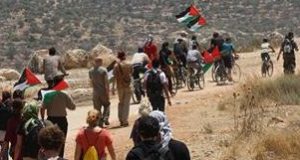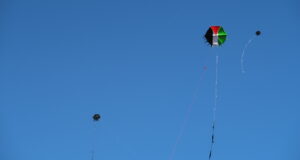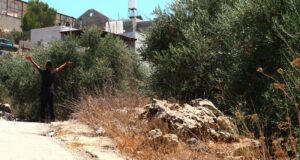Celebrating 40 Israeli and Palestinian peace builders
Three ISM Co-Founders Celebrated, Huwaida Arraf, Ghassan Andoni, Neta Golan
from American Friends Service Committee, 10 May 2007
June 2007 marks the 40th anniversary of the Israeli military occupation of Gaza and the West Bank. At AFSC, we’re taking this time to reflect on the Palestinian-Israeli conflict and to appreciate Palestinians and Israelis who have worked for peace and justice.
During May and June, AFSC presents Faces of Hope – Profiles of Peace. Profiles of Peace includes 40 short biographies of Israeli and Palestinian peace builders. A new profile will be added each weekday beginning May 1 and continuing through June 8. Follow the name links on this page to read each profile.
Also, please mark your calendars on June 10 and 11, 2007 for the rally, teach-in, and lobby day in Washington, DC, The World Says No to Israeli Occupation.
******************
Huwaida Arraf
Huwaida Arraf is a co-founder of the Palestinian-led International Solidarity Movement (ISM), which focuses on grassroots community nonviolent organizing to resist the Israeli occupation.
The founders of the ISM believed that bringing international volunteers to support the Palestinians under occupation would reduce the risk of violent repression of Palestinians by the Israeli military. Since its creation in April 2001, some 3,500 activist volunteers from more than 30 different countries have joined the ISM. The organization has been nominated for the Nobel Peace Prize twice, in 2003 and in 2004.
“The Palestinian Intifada, the ‘uprising for freedom,’ has got to be an international struggle. . .,” Arraf says. “[It] is a struggle for freedom, a struggle for basic human dignity and human rights. Anyone who believes in freedom, believes in justice, believes in equality for all people not based on religion or nationality, can join in the struggle.”
Arraf works in the occupied Palestinian territories with local leaders and groups, training international activists to face the Israeli military forces unarmed. She has been arrested more than a dozen times for nonviolent protests in the Occupied Territories, including once for delivering food to the people stranded in the Church of the Nativity in Bethlehem.
Born in Detroit, Michigan, the oldest of five children, Arraf attended the University of Michigan, Ann Arbor, where she obtained degrees in Arabic, Hebrew, and Judaic Studies, as well as political science. As an undergraduate, Arraf co-founded and facilitated an Arab-Jewish dialogue group on her campus and was active in other conflict resolution and co-existence groups. As a junior, she attended the Hebrew University in Jerusalem, and studied the Hebrew language on a Kibbutz. After graduating, Arraf worked at the Arab American Institute in Washington, D.C., promoting the rights of Arab Americans.
In the spring of 2000, Arraf traveled to Jerusalem to serve as program coordinator for Seeds of Peace, a U.S.-based nonprofit organization that promotes dialogue and interactions between young people in regions of conflict, in her case, Palestinians and Israelis. While working at Seeds of Peace, Arraf met her husband, Adam Shapiro, another co-founder of the ISM.
In 2004, Arraf co-edited the book Peace Under Fire, a collection of personal accounts by ISM volunteers, and is currently co-editing a book about the Palestinian resistance. She is a law student at the American University’s Washington College of Law, where she is focusing on International Human Rights and Humanitarian Law, with a special focus on war crimes prosecution. She also co-chairs the Students for Justice in Palestine at the Washington College of Law, serves on the advisory boards of KinderUSA and Imagine Life, and is a member of the steering committee for the U.S. Campaign to End the Israeli Occupation.
In 2006, Arraf traveled to Lebanon with her husband to coordinate civilian relief efforts in Lebanon and provide company for refugees returning to the south of Lebanon.
*************************
Ghassan Andoni
Palestinian co-founder of the Palestinian Center for Rapprochement Between People and the International Solidarity Movement. He has been a proponent of nonviolent resistance for decades.
Ghassan Andoni is a physics professor at Birzeit University who has combined his teaching with peace activism since 1988. He is best known for co-founding the Palestinian Center for Rapprochement Between People, but his peace activities began much earlier.
While a college student in Iraq, Andoni dropped out to work in refugee camps in Lebanon during the civil war there. Returning home from Lebanon he was arrested and jailed for two years for his supposed involvement in the military conflict. His Israeli judge refused to believe that he was a hospital worker and sentenced him for alleged membership in the Palestine Liberation Organization (PLO).
During the first intifada, 1987-1993, Andoni was an active participant in the tax resistance movement that took place in Beit Sahour, a town in the West Bank. He expanded his understanding of nonviolence from being a personal position to a public one that, if successfully employed, could lead to a mass movement of liberation.
In 1988, after another jail term for his participation in the tax revolt, he co-founded the Palestinian Center for Rapprochement between People. The center’s aim was to allow those in conflict to acknowledge each other’s humanity and to work together for a world in which they could peacefully coexist. It did this through dialogue and joint activities between Israelis and Palestinians. As the Israeli military occupation wore on, Andoni and the Rapprochement Center moved from dialogue to direct nonviolent action intended to end the occupation.
As part of this work he co-founded the International Solidarity Movement (ISM), coordinating international volunteers with Palestinians and Israelis in nonviolent actions that called attention to the oppression created by years of occupation. In working with ISM he has insisted that all international participants commit themselves to nonviolence, both physical and verbal.
“Conflicts are fueled by the tendency of the powerful to exploit the power and the anger and frustration of the powerless, which turns into violence,” Andoni says. “ISM activists are attempting to confront the exploitation of power and to bring back hope to the powerless.”
As he continued his peace work and organizing among Palestinian youth, Andoni demonstrated an ability to think strategically and tactically. He realized that a nonviolent movement must always be creative and experimental, not staying with patterns of behavior that once may have been successful but that, if made routine, run the risk of becoming rigid and mechanical.
His creative, proactive responses contributed to a growing prominence within the peace community, even as he turned from international work back toward a focus on Palestinian civil society. For this work, the AFSC nominated him and Israeli activist Jeff Halper for the Nobel Peace Prize in 2006. He currently works for Birzeit University as Director of Communications.
Read Andoni ’s statement after being nominated for the Nobel Peace Prize:HERE
*****************************
Neta Golan
Israeli co-founder of the International Solidarity Movement, which brings international solidarity activists to the West Bank and Gaza to engage in nonviolence resistance. In 2002, Golan was voluntarily stranded in Yasser Arafat’s compound that was besieged by Israeli forces. She wrote reports to the outside world about what she was experiencing.
Neta Golan was born in Tel Aviv and is a third generation Israeli. She describes her childhood as scary, loaded with fears instilled by her parents and fueled by the media. While she met Palestinian people working in construction and sanitation in Tel Aviv, barriers between the two peoples did not allow her to interact with Palestinian peoples as equals. She first heard of the occupation at the age of 15 during the first Palestinian Intifada.
This was her first venture into learning more about the Palestinian people and Israeli policies toward them. Having been raised with an awareness of oppression and dispossession in Jewish history, Golan’s first instincts were to question how Israel could be maintaining the oppression of another people.
She started to enter the West Bank to facilitate dialogues and meetings between Palestinians and Israelis. Through these trips into and around the West Bank, she came to understand the reality of Palestinian life under the occupation, and her fear transformed into action to help the Palestinian people.
At the start of the second intifada between 2000 and 2001, Golan helped to found the International Solidarity Movement (ISM), which brings international solidarity activists to the West Bank and Gaza to engage in nonviolent resistance. The international activists support the Palestinians in staging nonviolent demonstrations, confronting Israeli soldiers who violently suppress the Palestinians, and documenting human rights abuses and making those abuses public.
“What we want to do with the ISM is keep an avenue for popular struggle open,” Golan said in an article in the magazine Frontline (Vol. 19, Issue 17) published in 2002. “When we accompany Palestinians, because of the racism of the whole system, the army doesn’t treat us as targets the way they treat Palestinians. We want to expose the racist nature of the conflict by doing this, and also simply try to protect people so they can try to resist politically.”
In 2002, Golan was voluntarily stranded in Yasser Arafat’s presidential compound in Ramallah when it was besieged by Israeli forces. From within the compound, Golan wrote reports to the world outside of the compound about what was happening. She was hoping to reach the international community and move them to action, writing that “In the compound we are left wondering, not without fear, whether the international community will allow the permanent expansion of the already illegal occupation and the exile if not assassination of the Palestinian leader.”Focus on Trade, No. 76, 4/2002
Some of her other actions include chaining herself to olive trees to stop the Israeli military from uprooting them, and questioning the actions of Israeli soldiers at demonstrations,
While her family remains in Israel, Golan married a Palestinian man and lives with him and their children in the West Bank. She constantly deals with the ironies of her life: a resident of the occupied Palestinian territories, she can travel back and forth to Israel to visit with her family, but neither her husband nor her Palestinian friends can visit with their families if they are outside of the West Bank.
As she traveled to Israel to see her dying father for the last time, she recalled her Palestinian friend Amal, who “will never see her father again. Many thousands of Palestinians share her fate.” (Nablus to Tel Aviv, June 24, 2003).
***********************
Other Profiles of Peace include:
Haidar Abdul Shafi
Ali Abunimah
Arik Ascherman
Hanan Ashrawi
Naim Ateek
Uri Avnery
Khulood Badawi
Azmi Bishara
Eitan Bronstein
Elias Chacour
Sami Shalom Chetrit
Alex Cohn
Mona El-Farra
Nurit Peled-Elhanan
Rita Giacaman
Jeff Halper
Amira Hass
Jad Issac
Zahira Kamal
Laila Kanafani
Yehudit Keshet
Fatima Khaldi
Samiha Khalil
Felicia Langer
Ruchama Marton
Rela Mazali
Jessica Montell
Ilan Pappe
Matti Peled
Edward Said
Isam Sartawi
Yehuda Shaul
Raji Sourani
Gila Svirsky
Leah Tsemel
Michel Warchawski
Jean Zaru
 International Solidarity Movement Nonviolence. Justice. Freedom.
International Solidarity Movement Nonviolence. Justice. Freedom.






